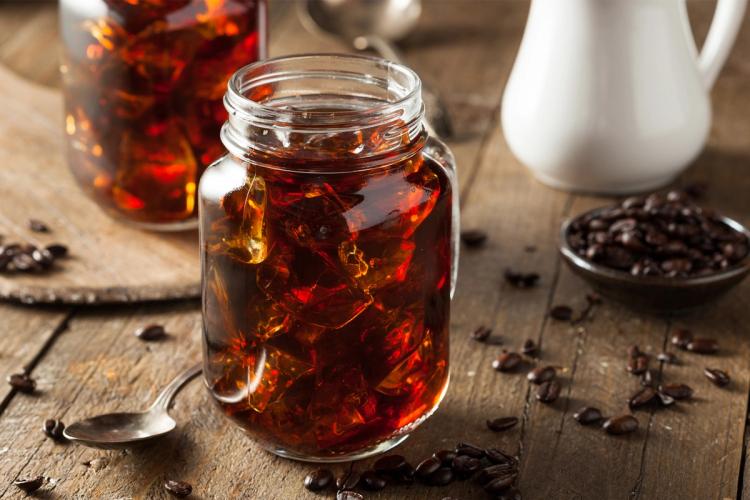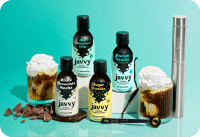
Cold Brew vs. Espresso: 3 Key Differences
Cold brew and espresso are two of the most foundational (and delicious) coffee beverages out there. These two powerhouses of the coffee world have stood at the top for years, and for good reason.
Both can be used to make all sorts of delicious beverages, give us a hit of caffeine, and are part of various new and interesting coffee trends.
Today, we’re going to do a quick comparison of these two coffee drinks. We’ll go through the obvious differences and dive into finer details you might not know. So keep reading to learn everything you need to know about the cold brew vs. espresso matchup.
1. Brew Methods
The most significant difference between these two types of coffee is how they are brewed. You could take the same coffee beans, brew them in these two different ways, and get wildly varying results. Let’s walk through the brew methods of each.
How To Brew Espresso
Brewing espresso is quite a complex and intricate process. There’s a reason why the espresso machine at your local coffee shop has so many dials, buttons, and levers: it’s a difficult drink to make.
The first step is grinding your coffee. Espresso beans are finely ground so that the water can extract as much coffee flavor as possible in a short amount of time. Now, measure out your grounds.
One espresso shot contains between 16 and 20 grams of coffee grounds, depending on who is brewing it.
Next, place your grounds in the portafilter. The portafilter is the metal contraption you place in and out of the espresso machine. It has a metal basket that holds the grounds, with fine holes at the bottom through which the finished espresso is pushed.
Once your grounds are in the portafilter, use your tamp to press them down with about 20 to 30 pounds of force. This forms a dense puck of espresso that helps generate the pressure required to brew espresso properly.
Now, place the portafilter into the espresso machine and press the brew button. There’s a lot of science and engineering inside that machine, but essentially, it forces hot water (about 204 degrees Fahrenheit) through the coffee grounds at approximately nine bars of pressure over 25 to 30 seconds.
Espresso is typically brewed with a 1:2 ratio of grounds to water, yielding between one and two ounces of the finished product.
So there you have your espresso. It’s a rich, concentrated form of coffee that may be tough to make, but it’s delicious to drink—especially when mixed with steamed milk to form a latte.
How To Brew Cold Brew
Cold brew has an entirely different brewing process. Start once again by grinding your coffee beans, but this time, grind them coarsely instead of finely.
To make cold brew coffee, you typically use a 1:4 to 1:8 ratio of coffee grounds to water, depending on the type of coffee and the recipe.
Now, grab a large pitcher or other liquid vessel and pour in your grounds along with water. Stir well to ensure that all the grounds are saturated with room-temperature water, then wait.
Cold brew requires a lot of patience. Recipes call for anywhere between 12 and 24 hours of steeping. Once the time is up, pour the coffee mixture through a filter to remove the grounds, and you’ve got a delicious batch of cold brew.
The result is a rich, strong coffee. It’s stronger (in taste and caffeine) than regular coffee but not quite as strong as espresso. Cold brewing creates a subtle sweetness, making the coffee refreshing and pleasant.
Another Type of Cold Brew
Recently, another cold brew method has been growing in popularity: cold brew concentrate. This creates a highly concentrated coffee that is similar in taste to espresso but brewed like cold brew.
To make cold brew concentrate, you still use coarsely ground coffee, cold water, and long brew times, but with a 1:1 ratio of coffee to water. This produces a highly concentrated coffee packed with rich flavors.
While regular cold brew can only be consumed plain or with a splash of milk or creamer, cold brew concentrate can be used like espresso. You can make lattes, Americanos, iced coffees, cappuccinos, and more.
So while cold brew concentrate is brewed like cold brew, it functions similarly to espresso.
2. Storage Times
A practical difference between cold brew and espresso is their storage time. If you’re making coffee at home, it’s important to know how long you can store it while keeping it fresh.
How To Store Espresso
A shot of espresso doesn’t retain its flavor for long. After just one day, even when stored in the fridge, espresso starts to lose its flavor and deteriorate, making it less than ideal for drinking.
After three to four days in the fridge, espresso will likely be bad and shouldn’t be consumed. If you do choose to store espresso, it’s best to keep it in a sealed container in the refrigerator.
How To Store Cold Brew
Cold brew lasts significantly longer than espresso. Due to its brewing method, cold brew stays fresh in the fridge for about one week to 10 days when properly stored.
To store cold brew, keep it in a sealed container in the fridge, and avoid adding ice to prevent dilution.
How To Store Cold Brew Concentrate
Cold brew concentrate has the longest shelf life of all three methods. Believe it or not, Javvy cold brew concentrate can last up to four to six weeks after being opened.
Just make sure you store it in its original bottle and close the lid properly before placing it in the fridge.
3. Accessibility
Espresso, cold brew, and cold brew concentrate all differ in accessibility. Accessibility matters because everyone deserves delicious coffee (and a little afternoon pick-me-up).
Let’s compare the accessibility of each type of coffee.
The Accessibility of Espresso
Espresso is the least accessible of these options. If you want a delicious espresso drink, you have two choices.
The first option is to visit a coffee shop and buy one. While convenient, a flavored latte can cost at least five or six dollars, making it expensive. Even a simple double shot of espresso costs about two dollars.
The second option is making espresso at home, but this is even less accessible. Not only do you need barista skills, but you also need an expensive espresso machine and a quality coffee grinder—not something everyone wants or can afford.
The Accessibility of Cold Brew
Cold brew is slightly more accessible than espresso. You can buy cold brew from a coffee shop or in bottled form at the store, but both options come with marked-up prices.
You can also brew your own cold brew at home, but it takes time and isn’t always the most efficient use of coffee beans.
The Accessibility of Cold Brew Concentrate
Cold brew concentrate is by far the most accessible option.
For example, one bottle of Javvy coffee concentrate contains 30 servings of coffee. It doesn’t get much more convenient than that. Plus, with a variety of fun flavors, the possibilities are nearly endless.
Cold Brew vs. Espresso
There are many differences between cold brew and espresso. If you’re a coffee drinker, you likely appreciate both. Few things beat a creamy latte made by your local barista.
However, when it comes to home coffee, cold brew—specifically cold brew concentrate—is a more convenient and efficient option than espresso. This magical solution to all your coffee needs is just a click away.
Check out Javvy and discover the joy of making your favorite coffee beverages right at home.






